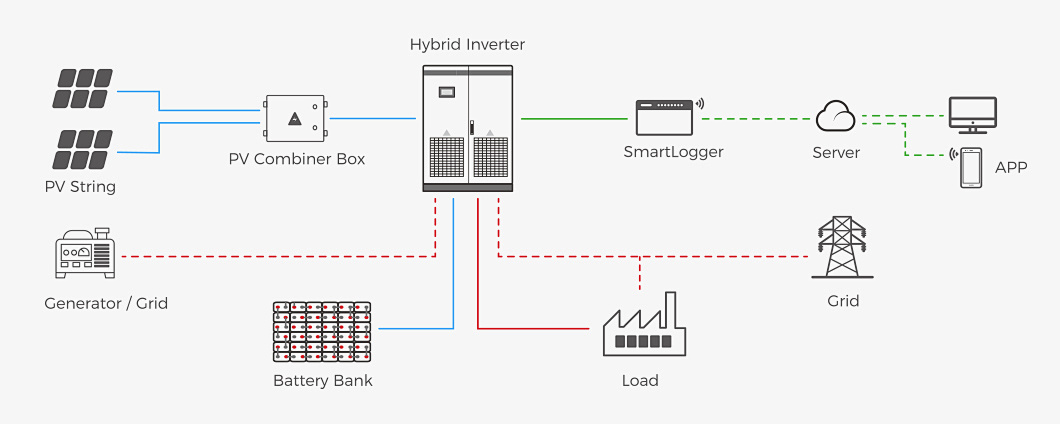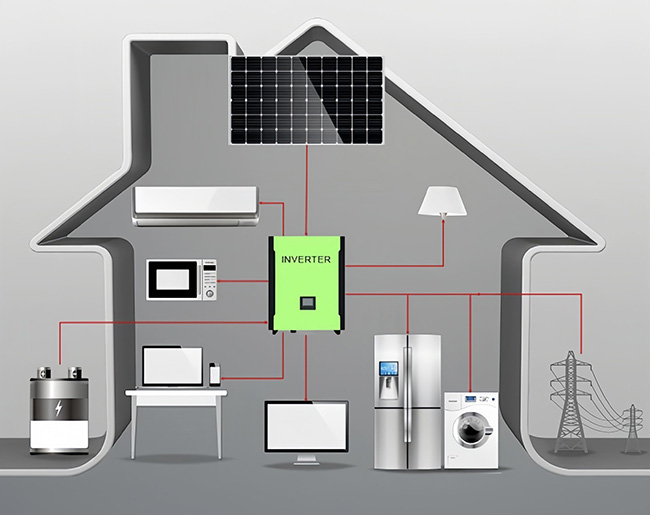Application of Hybrid Inverters in Small and Medium-Sized Enterprises
Hybrid inverters combine solar power systems with battery storage, allowing excess energy to be stored during the day and used at night or during power outages. EnterSolar aims to explore the application of hybrid inverters in a small to medium-sized business, evaluate its economic and environmental benefits, and share user experiences.

2. Hybrid Inverter Selection: A 10-kilowatt hybrid inverter was chosen, paired with a 30-kilowatt-hour battery storage system. The inverter features efficient MPPT (Maximum Power Point Tracking) functionality and an intelligent management system.
3. System Configuration and Layout: Solar panels were installed on the south-facing slope of the factory roof, and the battery storage system was installed indoors in a secure location to maximize solar energy and storage utilization.
2. Operation and Maintenance Costs: The maintenance costs for the hybrid inverter system are low, mainly involving periodic inspections and battery replacements, with annual maintenance costs around $500.
3. Savings on Electricity Bills and Payback Period: After installation, the monthly electricity bill was reduced from $1,000 to $400, resulting in annual savings of approximately $7,200. The projected payback period is around seven years, followed by at least 15 years of low-cost electricity use.
2. Positive Environmental Impact: By reducing reliance on traditional fossil fuels, the system helps mitigate environmental pollution and contributes to improving local air quality.

2. Challenges and Solutions: The main challenge was the high initial investment cost, which was addressed through business loans and government subsidies. During installation, structural limitations of the factory roof were encountered and resolved by reinforcing the roof structure.
Case Background
This case study focuses on a business located in Austin, Texas, primarily engaged in electronic product assembly. The business occupies an area of approximately 1,000 square meters, employs 50 people, and has an average monthly electricity consumption of around 4,000 kilowatt-hours. Due to high electricity rates and frequent power outages in the area, the business decided to install a hybrid inverter system to reduce electricity costs and improve power supply stability.
Hybrid Inverter Installation and Configuration
1. Installation Process: The installation process included assessing electricity needs, designing the system layout, procuring equipment, installing the hybrid inverter, connecting to the grid, and commissioning. The entire process took about one month and was completed by a professional company.2. Hybrid Inverter Selection: A 10-kilowatt hybrid inverter was chosen, paired with a 30-kilowatt-hour battery storage system. The inverter features efficient MPPT (Maximum Power Point Tracking) functionality and an intelligent management system.
3. System Configuration and Layout: Solar panels were installed on the south-facing slope of the factory roof, and the battery storage system was installed indoors in a secure location to maximize solar energy and storage utilization.
Economic Benefit Analysis
1. Initial Investment Cost: The total investment cost was approximately $50,000, including equipment procurement, installation fees, and net cost after tax incentives.2. Operation and Maintenance Costs: The maintenance costs for the hybrid inverter system are low, mainly involving periodic inspections and battery replacements, with annual maintenance costs around $500.
3. Savings on Electricity Bills and Payback Period: After installation, the monthly electricity bill was reduced from $1,000 to $400, resulting in annual savings of approximately $7,200. The projected payback period is around seven years, followed by at least 15 years of low-cost electricity use.
Environmental Benefit Analysis
1. Reduction in Carbon Emissions: The system reduces approximately 20 tons of carbon dioxide emissions annually, equivalent to planting 600 trees.2. Positive Environmental Impact: By reducing reliance on traditional fossil fuels, the system helps mitigate environmental pollution and contributes to improving local air quality.

User Feedback and Experience
1. User Experience: The business owner is highly satisfied with the performance of the hybrid inverter system, especially the ability to maintain normal production during power outages. The system operates stably, and the intelligent management features enhance energy efficiency. The inclusion of solar power inverters further optimizes the conversion of solar energy, contributing to overall system effectiveness.2. Challenges and Solutions: The main challenge was the high initial investment cost, which was addressed through business loans and government subsidies. During installation, structural limitations of the factory roof were encountered and resolved by reinforcing the roof structure.
